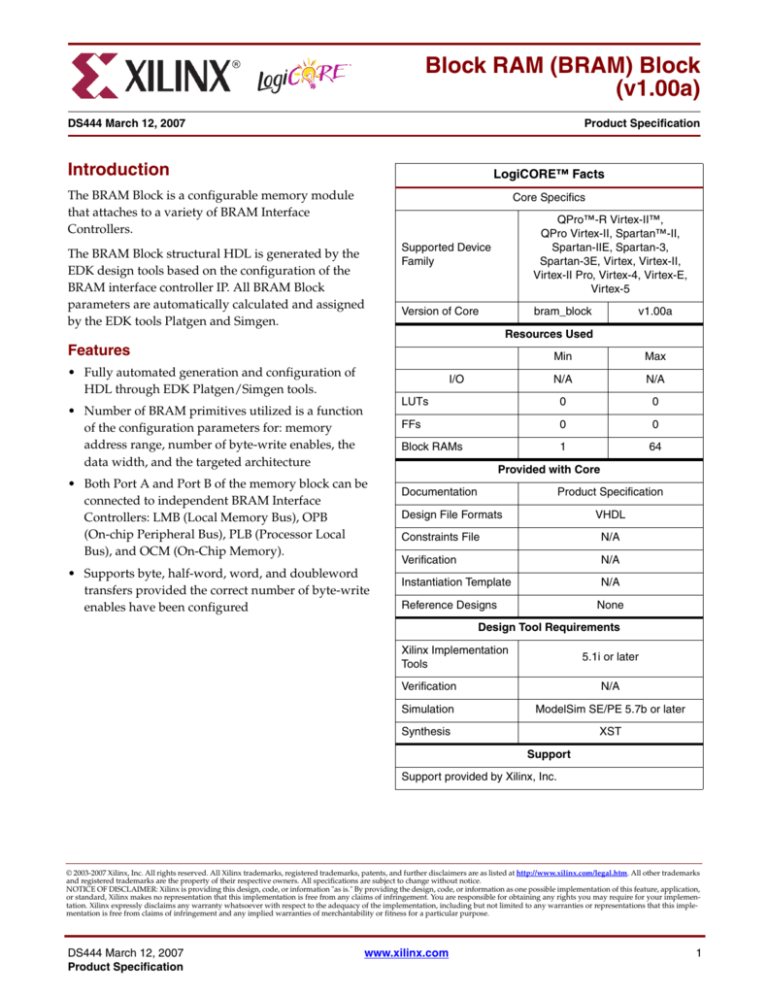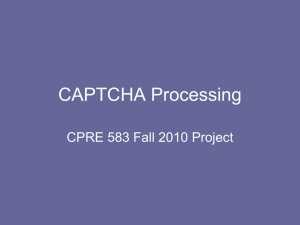
0
Block RAM (BRAM) Block
(v1.00a)
DS444 March 12, 2007
0
Product Specification
0
Introduction
LogiCORE™ Facts
The BRAM Block is a configurable memory module
that attaches to a variety of BRAM Interface
Controllers.
Core Specifics
The BRAM Block structural HDL is generated by the
EDK design tools based on the configuration of the
BRAM interface controller IP. All BRAM Block
parameters are automatically calculated and assigned
by the EDK tools Platgen and Simgen.
Supported Device
Family
QPro™-R Virtex-II™,
QPro Virtex-II, Spartan™-II,
Spartan-IIE, Spartan-3,
Spartan-3E, Virtex, Virtex-II,
Virtex-II Pro, Virtex-4, Virtex-E,
Virtex-5
Version of Core
bram_block
v1.00a
Resources Used
Features
Min
Max
N/A
N/A
LUTs
0
0
FFs
0
0
Block RAMs
1
64
• Fully automated generation and configuration of
HDL through EDK Platgen/Simgen tools.
I/O
• Number of BRAM primitives utilized is a function
of the configuration parameters for: memory
address range, number of byte-write enables, the
data width, and the targeted architecture
Provided with Core
• Both Port A and Port B of the memory block can be
connected to independent BRAM Interface
Controllers: LMB (Local Memory Bus), OPB
(On-chip Peripheral Bus), PLB (Processor Local
Bus), and OCM (On-Chip Memory).
• Supports byte, half-word, word, and doubleword
transfers provided the correct number of byte-write
enables have been configured
Documentation
Product Specification
Design File Formats
VHDL
Constraints File
N/A
Verification
N/A
Instantiation Template
N/A
Reference Designs
None
Design Tool Requirements
Xilinx Implementation
Tools
5.1i or later
Verification
N/A
Simulation
ModelSim SE/PE 5.7b or later
Synthesis
XST
Support
Support provided by Xilinx, Inc.
© 2003-2007 Xilinx, Inc. All rights reserved. All Xilinx trademarks, registered trademarks, patents, and further disclaimers are as listed at http://www.xilinx.com/legal.htm. All other trademarks
and registered trademarks are the property of their respective owners. All specifications are subject to change without notice.
NOTICE OF DISCLAIMER: Xilinx is providing this design, code, or information "as is." By providing the design, code, or information as one possible implementation of this feature, application,
or standard, Xilinx makes no representation that this implementation is free from any claims of infringement. You are responsible for obtaining any rights you may require for your implementation. Xilinx expressly disclaims any warranty whatsoever with respect to the adequacy of the implementation, including but not limited to any warranties or representations that this implementation is free from claims of infringement and any implied warranties of merchantability or fitness for a particular purpose.
DS444 March 12, 2007
Product Specification
www.xilinx.com
1
Block RAM (BRAM) Block (v1.00a)
Functional Description
The BRAM Block is a structural design that instantiates a number of RAMB primitives, depending on
specific factors. An example is shown in Figure 1.
Figure Top x-ref 1
port_B[0 to 7]
port_A[0 to 7]
RAMB16_s8_s8
port_B[0 to 7]
port_A[0 to 7]
RAMB16_s8_s8
port_A[0 to 31]
port_B[0 to 7]
port_A[0 to 7]
RAMB16_s8_s8
port_B[0 to 7]
port_A[0 to 7]
RAMB16_s8_s8
ds444_01
Figure 1: Example of BRAM Block implementation with 4 RAMB16 primitives
BRAM Block I/O Signals
The I/O signals for the BRAM Block are shown in Figure 1 and described in Table 1. Note that the data
in/out signals are named the opposite of their actual direction. This is because the signals are
referenced from the point of view of the BRAM controller so that “data in” on the controller connects to
“data in” on the BRAM block, and “data out” on the controller connects to “data out” on the BRAM
block.
Table 1: BRAM Block I/O Signals
Signal Name
2
Initial
State
Interface
I/O
BRAM_Rst_A
Port A
I
BRAM Reset, Active High
BRAM_Clk_A
Port A
I
BRAM Clock
BRAM_EN_A
Port A
I
BRAM Enable, Active High
BRAM_WEN_A
Port A
I
BRAM Write Enable, Active High
BRAM_Addr_A
(0:C_PORT_AWIDTH-1)
Port A
I
BRAM Address
BRAM_Din_A
(0:C_PORT_DWIDTH-1)
Port A
O
BRAM_Dout_A
(0:C_PORT_DWIDTH-1)
Port A
I
BRAM Data Input. Note signal name is referenced
from the point of view of the controller (on which it is
an output).
BRAM_Rst_B
Port B
I
BRAM Reset, Active High
BRAM_Clk_B
Port B
I
BRAM Clock
BRAM_EN_B
Port B
I
BRAM Enable, Active High
BRAM_WEN_B
Port B
I
BRAM Write Enable, Active High
0
Description
BRAM Data Output. Note signal name is referenced
from the point of view of the controller (on which it is
an input).
www.xilinx.com
DS444 March 12, 2007
Product Specification
Block RAM (BRAM) Block (v1.00a)
Table 1: BRAM Block I/O Signals (Contd)
Signal Name
Interface
I/O
BRAM_Addr_B
(0:C_PORT_AWIDTH-1)
Port B
I
BRAM_Din_B
(0:C_PORT_DWIDTH-1)
Port B
O
BRAM_Dout_B
(0:C_PORT_DWIDTH-1)
Port B
I
Initial
State
Description
BRAM Address
0
BRAM Data Output. Note signal name is referenced
from the point of view of the controller (on which it is
an input).
BRAM Data Input. Note signal name is referenced
from the point of view of the controller (on which it is
an output).
BRAM Block Parameters
Table 2: BRAM block Parameters
Parameter
Name
Feature/Description
Allowable
Values
Tool
Calculated
VHDL
Type
C_PORT_
AWIDTH
Port A and B Address Width
9 – 17
Yes
integer
C_PORT_
DWIDTH
Port A and B Data Width
32, 64
Yes
integer
C_NUM_WE
Number of Write Enables (Byte Enables for
Write)
1, 2, 4, 8
Yes
integer
spartan2,
spartan2e,
spartan3,
virtex, virtexe,
virtex2,
qvirtex2,
qrvirtex2,
virtex2p, virtex4
Yes
string
512 - 131072
Yes
integer
C_FAMILY
Target FPGA family of bram_block
C_MEMSIZE
Size of BRAM(s) in bytes
Allowable Parameter Combinations
For architectures with 4kb RAMB primitives (C_FAMILY equals one of spartan2, spartan2e, virtex, or
virtexe), the maximum value for C_MEMSIZE is 32kB.
For architectures with 16kb RAMB primitives (C_FAMILY equals one of spartan3, virtex2, qvirtex2,
qrvirtex2, virtex2p, or virtex4), the minimum value for C_MEMSIZE is 2kB.
Parameter - Port Dependencies
The width of many of the BRAM Block signals depends on the number of memories in the system and
the width of the various data and address buses. The dependencies between the BRAM design
parameters and I/O signals are shown in Table 3.
DS444 March 12, 2007
Product Specification
www.xilinx.com
3
Block RAM (BRAM) Block (v1.00a)
Table 3: Parameter-Port Dependencies
Name
Affects
Depends
Relationship Description
Design Parameters
C_PORT_
DWIDTH
BRAM_Din_A/B
BRAM_Dout_A/B
0 to C_PORT_DWIDTH -1
0 to C_PORT_DWIDTH -1
Width of BRAM interface
Width of BRAM interface
C_PORT_
AWDITH
BRAM_Addr_A/B
0 to C_PORT_AWIDTH -1
Width of the BRAM Address Bus
C_NUM_WE
BRAM_WEN_A/B
0 to C_NUM_WE -1
Number of byte enable signals
I/O Signals
BRAM_Addr_A
C_PORT_AWIDTH
Width varies with the width of the BRAM
Address Bus
BRAM_Din_A
C_PORT_DWIDTH
Width varies with the width of the BRAM
Data Bus
BRAM_Dout_A
C_PORT_DWIDTH
Width varies with the width of the BRAM
Data Bus
BRAM_WEN_A
C_NUM_WE
Width varies with the number of
byte-write enable signals
BRAM_Addr_B
C_PORT_AWIDTH
Width varies with the width of the BRAM
Address Bus.
BRAM_Din_B
C_PORT_DWIDTH
Width varies with the width of the BRAM
Data Bus.
BRAM_Dout_B
C_PORT_DWIDTH
Width varies with the width of the BRAM
Data Bus.
BRAM_WEN_B
C_NUM_WE
Width varies with the number of
byte-write enable signals
BRAM Block Register Descriptions
Not applicable.
BRAM Block Interrupt Descriptions
Not applicable.
The BRAM Block is a structural design that instantiates a number of RAMB primitives. The number of
block RAM primitives instantiated in a BRAM Block depends on the following factors
• Each primitive is either 4kb or 16kb depending on architecture. The address range
(C_PORT_AWIDTH) times the accessed data width (C_PORT_DWIDTH) defines the total number
of bits required.
• Instantiated RAMB primitives can be configured to have at most a 32 bit wide data interface. Thus
a 64 bit interface will require at least 2 BRAM primitives in parallel.
• RAMB primitive in architectures prior to Virtex-4 only have a single write enable per port. Thus if
byte-write enable is required on a 32 bit data port (C_NUM_WE=4), these architectures will use a
minimum of 4 BRAM primitives.
4
www.xilinx.com
DS444 March 12, 2007
Product Specification
Block RAM (BRAM) Block (v1.00a)
Design Implementation
Design Tools
The BRAM Block design is generated by the EDK tools.
XST is the synthesis tool used for synthesizing the BRAM Block. The EDIF netlist output from XST is
then input to the Xilinx Alliance tool suite for actual device implementation.
Target Technology
The intended target technology is an FPGA in one of the following families: Virtex, Virtex-E, Spartan-II,
Spartan-IIE, Spartan-3, Virtex-II, QPro Virtex-II, QPro-R Virtex-II, Virtex-II Pro, or Virtex-4.
Device Utilization and Performance Benchmarks
The device utilization depends on the configured BRAM Block size in relation to the RAMB primitive
resources of the targeted device. See the user guide for the respective FPGA family for details on RAMB
primitive performance and available resources.
Specification Exceptions
Not applicable.
Reference Documents
None
Revision History
The following table shows the revision history for this document.
Date
Version
01/07/03
1.3
Updated for EDK SP3.
07/22/03
1.4
Updated to new template.
08/03/04
1.5
Updated with new families and added detail on BRAM primitive usage. Reformatted
8/13/04
1.5.1
4/2/05
1.6
Updated for EDK 7.1.1 SP1; updated supported device family listing.
8/1/05
1.7
Converted to new DS template; no content edited.
12/1/05
1.8
Added Spartan-3E to supported device listing.
8/21/06
1.9
C_MEMSIZE description corrected
3/12/07
1.10
Added Virtex-5 support.
DS444 March 12, 2007
Product Specification
Revision
Updated for Gmm: reviewed and corrected trademarks.
www.xilinx.com
5







